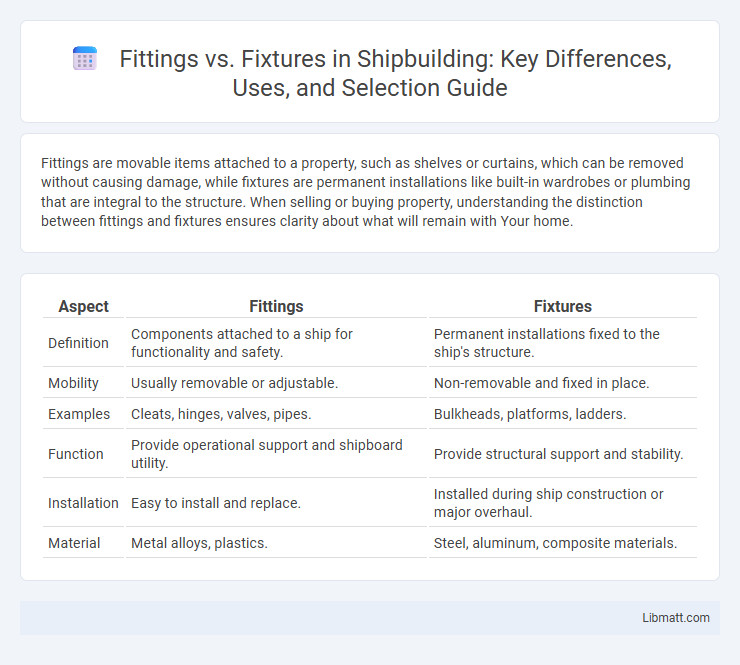Fittings are movable items attached to a property, such as shelves or curtains, which can be removed without causing damage, while fixtures are permanent installations like built-in wardrobes or plumbing that are integral to the structure. When selling or buying property, understanding the distinction between fittings and fixtures ensures clarity about what will remain with Your home.
Table of Comparison
| Aspect | Fittings | Fixtures |
|---|---|---|
| Definition | Components attached to a ship for functionality and safety. | Permanent installations fixed to the ship's structure. |
| Mobility | Usually removable or adjustable. | Non-removable and fixed in place. |
| Examples | Cleats, hinges, valves, pipes. | Bulkheads, platforms, ladders. |
| Function | Provide operational support and shipboard utility. | Provide structural support and stability. |
| Installation | Easy to install and replace. | Installed during ship construction or major overhaul. |
| Material | Metal alloys, plastics. | Steel, aluminum, composite materials. |
Introduction to Fittings and Fixtures
Fittings and fixtures are essential components in construction and interior design, with fittings referring to movable or replaceable parts such as door handles, taps, and light bulbs, while fixtures are fixed installations like sinks, bathtubs, and built-in cabinetry. Understanding the distinction helps you plan and budget effectively for your space, ensuring each element serves its intended function and enhances overall design. Proper selection of fittings and fixtures impacts both aesthetics and functionality, contributing to the comfort and usability of your environment.
Definition of Fittings
Fittings refer to the small, removable components attached to furniture, plumbing, or equipment that enhance functionality, such as handles, taps, or brackets. These elements are typically designed for easy installation and replacement, distinguishing them from permanent fixtures. Your choice of fittings can significantly influence the convenience and aesthetic appeal of a space.
Definition of Fixtures
Fixtures are items permanently attached to a property, such as built-in cabinets, plumbing installations, and lighting systems, which are considered part of the real estate. Unlike fittings, fixtures cannot be removed without causing damage to the property or affecting its structural integrity. Property laws typically classify fixtures as part of the property during sales and leases, impacting ownership rights and obligations.
Key Differences Between Fittings and Fixtures
Fittings are removable components attached to a building, such as taps, lamps, or shelves, that can be replaced or moved without damaging the structure. Fixtures are permanent installations like sinks, bathtubs, or built-in cabinets, firmly affixed to the property and often considered part of the real estate during property transactions. Understanding these key differences helps you determine what items remain with the property and which ones can be taken when moving or renovating.
Types of Fittings in Homes and Offices
Types of fittings in homes and offices include door handles, hinges, cabinet knobs, and pipe connectors, which are essential for assembly and mechanical support. Electrical fittings like switches, sockets, and light fixtures ensure safe and efficient power distribution within spaces. Your choice of fittings impacts both functionality and aesthetics, enhancing the overall usability and design of interiors.
Types of Fixtures in Homes and Offices
Fixtures in homes and offices include lighting fixtures such as chandeliers, recessed lights, and wall sconces, as well as plumbing fixtures like sinks, toilets, and faucets, all of which are permanently attached to the structure. Built-in cabinets, shelves, and HVAC vents also qualify as fixtures due to their fixed installation. Understanding the difference between fittings and fixtures helps you manage property value and maintenance, as fixtures are considered part of the real estate and cannot be easily removed without damage.
Legal Implications: Fittings vs Fixtures
Legal implications between fittings and fixtures critically affect property transactions and ownership rights. Fixtures are items legally attached to the property and typically transfer with it, impacting lease agreements and sale contracts, whereas fittings are movable and can be removed by the seller or landlord without legal dispute. Understanding whether an item is classified as a fitting or fixture can protect your interests during property sales or rentals by clarifying what must remain or can be taken.
Factors to Consider When Choosing Fittings and Fixtures
When choosing fittings and fixtures, consider durability, functionality, and style to match your space's requirements. Assess the material quality and maintenance needs, as high-grade metals or ceramics ensure longevity and performance. Your choice should also align with budget constraints while enhancing the aesthetic appeal and usability of the room.
Maintenance and Durability Comparison
Fittings typically require less maintenance due to their simpler design and use of durable materials like metal or plastic, making them resistant to wear and corrosion. Fixtures, often integrated into building structures, may demand more frequent upkeep to preserve functionality and appearance, particularly if made from materials susceptible to moisture or mechanical stress. Your choice between fittings and fixtures should consider the long-term maintenance needs and durability to ensure cost-effective performance in your property.
Conclusion: Fittings vs Fixtures
Fittings and fixtures both play essential roles in interior and building design, with fittings referring to movable or attachable components such as handles, taps, and light bulbs, while fixtures are fixed items like sinks, built-in cabinets, and toilets. Understanding the distinction ensures accurate budgeting, installation, and maintenance in construction and home improvement projects. Choosing the right combination of fittings and fixtures enhances functionality, aesthetics, and property value effectively.
Fittings vs fixtures Infographic

 libmatt.com
libmatt.com